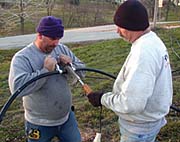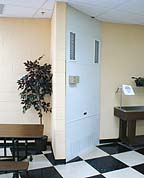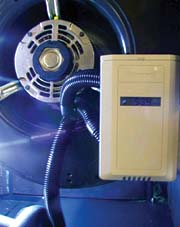
Jones is the owner of HVAC contracting firm Air-Flo and a managing partner of Hydro-Temp Corp., both in Pocahontas.
Hydro-Temp manufactures Geoexchange heat pumps, specializing in applications where every penny counts, such as schools. On some jobs, Air-Flo installs them.
“I was raised poor,” Jones explains. Therefore, when he designs a system, “I always act like this money is mine.”

A school constructed last year in Fayette, Mo., may have resulted in an application of this type with the lowest documented school energy consumption per square foot. The company is checking the record books, but it’s safe to say that Fayette High School’s 2.3- to 2.4-kWh/square-foot usage — which includes cooling, heating, and hot water heating — is breaking some records.
There is a corner unit in every classroom, plus units in the cafeteria and library. “The gym has four big horizontal loops, 15 or 20 tons,” says Barry Ferguson, a design engineer with BDS Energy Inc., Cabot, Ark. It is not always air conditioned, he explains, but the capacity is there for special events such as graduation.

Critical Elements
Jones is the first to state, “The results were achieved due to a close working relationship with the design architect [ACI-Boland], construction manager, and the Hydro-Temp design team. The use of the ... Corner Console units and a well-insulated building made for a terrific performance combination.”The insulation itself was important to Jones. “Walls were a brick/block combination with three inches of Styrofoam®, along with three inches on the roof and double-pane windows.”
Ferguson says, “We’re a stickler on insulation and high-efficiency windows. You worry about the air conditioning after you look at the wall and roof insulation and the windows.”
Ferguson has been working with Jones on geothermal systems for six or seven years. He frequently has requested design modifications to the systems, and Jones has added these innovations whenever possible. Like some air-handling units, Jones’ geothermal heat pumps are built to spec for any particular job, with a variety of options available.

Ferguson says he was in a school one day and was looking at corners; they generally were not used, and amounted to wasted space. He and Jones “took the idea home to the office.” (Jones also recalls a brainstorm around 5 a.m. one morning that paid off.) One of Hydro-Temp’s engineers, Henry Gross, and Jones worked to put together a unit that fits in corners, taking up about 4-1/2 square feet of floor space. The unit fits through standard doorways.
“You can get a corner system and loop put in for a little more than the cost of split systems with ductwork,” says Ferguson. There is a reduced operational cost, Jones explains, because the systems are designed so that pumps are not oversized and there is no duct loss because duct use is limited.
“The savings of geothermal are real,” Jones says.

Air Quality Considerations
The geothermal heat pumps at Fayette H.S. can bring in up to 400 cfm of fresh air and include a CO2 sensor. After 1:00 or 1:30 p.m. during the school year, Jones says, the units automatically draw in fresh air without interruption.Ferguson points out that although the units meet outdoor air requirements, the air available is not necessarily of good quality. That’s why he and Jones have looked at preconditioning, using multistage compressors for applications of 3 tons and up. He acknowledges the importance of “finding a manufacturer that is not cookie-cutter in its approach.”
Summer vacation operation is another concern for school systems. “We recommend never to set back to more than 84 degrees F,” says Ferguson. “We prefer 82 degrees.” This is due to the mass load created by the heating of elements within the room. Ferguson compares it to stones around a campfire: “You may put out the fire, but it takes eight hours before those rocks cool down.”
Latent load is another factor. “If the unit has not run for an hour,” he says, “it will automatically run for 10 minutes.”

“It’s proven,” Jones says. “It’s not over-engineered. What we do is not rocket science. If it was, I wouldn’t be able to do it.”
Ferguson adds, “If we keep it simple, we have it better in the long run.” For one thing, it is easier for building operations to maintain and run.
Hydro-Temp offers a two-day school that is recommended for maintenance and operations staff. “I would say that 99 percent of our customers send their people,” Ferguson says. “I also have contractors that go to the school.”

Networking
It may take schooling through the company, as well as working on a couple of smaller jobs, before Ferguson will let a contractor work on one of his projects. “I’ve been doing this seven or eight years,” he says. “My first few jobs were nightmares; the contractor didn’t know how to purge or do reverse-header systems.”According to Jones, “We go after a specific type of dealer that wants the best he can get.”
Once your foot is in the door, these companies believe in building on existing relationships to do new projects. “Why not go home with the girl you took to dinner?” says Ferguson.
He and Jones have found several cases where the building owners and school districts were interested in installing a geothermal system, but the HVAC firms they first contacted either didn’t understand geothermal themselves, or they felt that their customers really didn’t understand it. What these firms don’t seem to grasp, says Jones, is that “These customers are intelligent people! They understand the concept.”
Howard Electric Cooperative Corp. has metered Fayette High School’s HVAC and hot water energy consumption; manager Richard Fowler has provided metering and documentation. The co-op is helping compare the school’s energy consumption figures with those from the Geothermal Heat Pump Consortium (GHPC). So far the lowest is 10 kWh/square foot/year for heating and cooling, Jones says, noting that Fayette High School’s results “are not an isolated case. They can be repeated anywhere.”
Jones states, “The Hydro-Temp design team will work with any architect or engineer to help achieve similar results, like others have all over the country. The earlier in the design process this all begins, the better the end results will be. There’s no miracles in our business. We have to earn everything we do.”
Publication date: 08/18/2003

Report Abusive Comment